A.2 inserted
A.2.1 Email Templates
Administrators can customize the content and template details for emails automatically generated by the system within the Templates tab.
The labels for the Templates are generated in English, but can be customized within the Setup>Localization>Content tab.
The filter views within the Templates tab include:
|
View Option |
Description |
|---|---|
|
Full Email Templates |
Allows Users to customize the content and insert parameters of emails automatically generated and sent by the system. |
|
Email Summary Templates |
Users configure the content of templates that are included in the automatically generated emails, which summarize the specific details of the matter at hand. See:Summary Templates |
|
Email Keywords |
Allows Users to enter alternative words for the system to use when sending mail and parsing emails received at the support email address. See: Keywords for a description of where the words are used by the system. |
|
Error Message Templates |
Allows the Use to customize the error messages automatically generated and sent by the system. See: Error Messages. |
|
Out of Office |
Allows the User to customize multiple Out of Office options for the system to identify in incoming email Subject lines, so it knows to ignore the email. See: Out of Office. |
|
SMS Templates |
Allows Users to customize the content and insert parameters for text messages automatically generated and sent by the system. |
Content for the automatically generated email messages sent by the system is configured within the Full Email Templates filter screen of the Email > Templates tab. In addition to customizing the content of the messages, there is also the facility to insert parameters for specific details sourced from the database.
The template parameters, look and feel of email messages sent in regard to Knowledge Base Articles, Items, Requests, Invoices and Contracts are configured within the Email Summary Templates filter screen of the Templates tab.
Configuring Full Email Templates
To configure messages:
-
Select Setup>Templates>Full Email Templates filter
The Full Email Template filter screen is displayed.
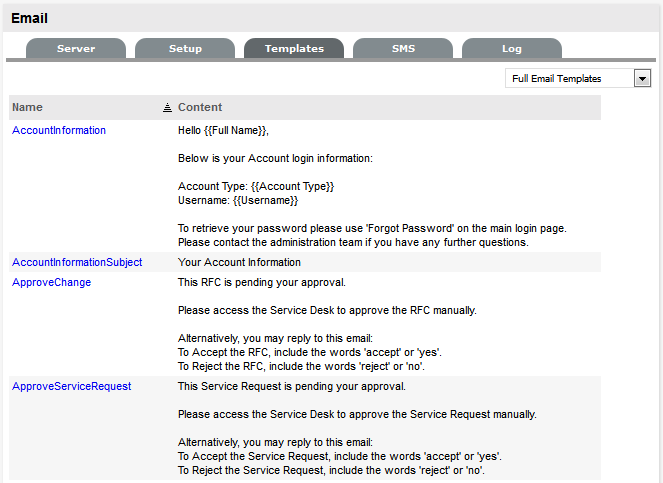
Email Templates
AccountInformation
Sent when a Customer or User is emailed the login details of their account.
AccountInformation Subject
Content to be included in the Email Subject line when a Customer or User is emailed the login details of their account.
ApproveChange
Message sent to Managers when an RFC moves to an Approval State.
The configured message must indicate to Managers that they are specific with their reply, using:
The words 'accept' or 'yes', to Accept the Change
The words 'reject' or 'no', to Reject the Change.
ApproveServiceRequest
Message sent to Managers when a Service Request moves into an Approval State.
The configured message must indicate to Managers that they are specific with their reply, using:
The words 'accept' or 'yes', to Accept the Change
The words 'reject' or 'no', to Reject the Change.
ClosedPrefix
Included at the beginning of the email when a request is closed.
ClosedTimeout
Used by the handshake facility and prefaces emails sent as Incident Note using the Propose button.
CloseRequest
Message included in the Email that uses the handshaking facility and proposes a Solution to the Customer.
CloseRequestLink
The message sent with the hyperlink to enable Customers to keep a request open after a possible solution has been sent to them. This template is used in conjunction with the CloseRequest message when the Handshaking facility is used to by a Technician to propose a Note as a solution.
ContractExpired Message
Email sent to a Customer when a Contract has expired and a new request is logged or an existing request is still open when the expiration date is hit.
ContractTimeElapsed (Subject Line)
Subject line for ContractExpiredMessage, which is he email sent to a Customer when a Contract period has elapsed or all purchased support hours have been used.
ContractTimeLow
Email sent to a Customer when the amount of time remaining on a Contract triggers the low time percentage threshold. (The default percentage is defined in the Setup>Billing>Contracts tab.)
CreateChange
Included at the beginning of the email to a Customer when a Change Request is first created.
CreateIncident
Included at the beginning of the email to a Customer when an Incident is first created.
CreateProblem
Included at the beginning of the email to a Customer when a Problem is first created.
CreateServiceRequest
Included at the beginning of the email to a Customer when a Service Request is first created.
InvoicePrefix
Included at the start of an email sent to the Customer with a newly created Invoice.
(This email content is also used for the email sent to Customers when the Setup>Billing>Contracts option is enabled and the number of days for the Subscription "Contract Renewal Time" is triggered.)
ItemStatusChangePrefix
Included at the beginning of the email sent to a Customer when an Item Status has been amended and the option to notify customer is selected in the Item Information tab.
LDAPInformation
Sent when a new Customer or User is emailed the login details of their account after an authentication server synch.
NewAttachmentToTech
Sent when to a User when a new attachment is added to a request in the Customer Portal.
NoAccount
This message is sent to a Customer when they have attempted to log an Incident via Email but are not registered with the system.
NOTE:The Subject line of this email can be customized in the Error Message Templates filter of the Email>Templates tab.
NoContractCreate
RequestSummary
Message sent to a Customer to inform them that work cannot commence on newly logged request as no contract is in place.
NoContractReminder
Summary
Reminder message sent to a Customer to inform them that work cannot commence on newly logged request as no contract is in place.
NoteClosedPrefix
Email sent to a Customer when they have sent an email Note to the system, when a request was already closed.
NotePrefix
Included each time a new Note is associated with an existing request.
PasswordLost
Sent when a Customer or User is emailed their account information for login as a result of their selecting the Forgot Password link on the Login Page.
PasswordQuestion
Sent when a Customer or User is emailed a challenge question for resetting their password for login as a result of their selecting the Forgot Password link on the Login Page. (The Password Questions option is enabled in the Setup>Privileges>System tab. The questions/answers are set within the Customer/User My Account Information screen.)
PasswordReset
Sent when a Customer or User is emailed their account information for login after their Password has been re-set within the Customer Information or User Information screen.
PlannedOutagePrefix
Included in the email sent when an Item is scheduled to be taken offline.
RequestAccepted
Prefix
Acknowledgement sent to the person responsible for a Request in an Approval State, when a Request is approved.
RequestDeescalate
FromTo
When a request is manually de-escalated this message is sent to the newly assigned Technician.
RequestDeescalate
NotAvailable
When a request is manually de-escalated this message is sent to the previously assigned Technician to let them know that the request is no longer available for them to work on.
RequestEscalateFromTo
When a request is manually escalated this message is sent to the newly assigned Technician.
RequestEscalateNotAvailable
When a request is manually escalated this message is sent to the previously assigned Technician to let them know that the request is no longer available for them to work on.
RequestReassignedManager
Prefix
This message is sent when the Manager responsible for processing the approval of a request is changed and is sent to the previously assigned Manager.
RequestReassignedManager
ToTechPrefix
The message included in an email when a request moves from a Manager Approval State to the newly assigned Technician User.
RequestReassignPrefix
When a request is reassigned this message is sent with the request details to the previously assigned User.
RequestReassignToPrefix
When a request is reassigned this message is sent with the request details to the newly assigned User.
RequestRejectedPrefix
Acknowledgement sent to the person responsible for a Request in an Approval State, when a Request is rejected.
RequestStatusChanged
Prefix
The content of an email sent when the Status of a request is moved from Pending-No Contract to the default open state of the assigned Workflow. This is sent to the assigned Technician.
RequestStatusChanged
Subject
The content of the sent when the Status of a request is moved from Pending-No Contract to the default open state of the assigned Workflow. This is sent to the assigned Technician.
RequestWorkaround
Message sent when a Workaround is applied to a request in the Analysis tab and emailed to the Customer.
Responder
Message sent from the monitored email account when the system does not accept new requests via email.
Signature
The details included at the bottom of emails sent from the system.
NOTE:Signatures can be customized on a per Team basis in the Setup>Localization>Content tab.
SlaBreached
Email sent to the assigned User when an SLA is breached.
SlaBreachedSubject
The content in the Subject line of an email sent to an assigned User and Service Level Manager, and if configured within the SLA the Team Lead, when an SLA is breached.
SlaTimeElapsed
Sent to the assigned User and Service Level Manager, and if configured within the SLA the Team Lead, when an SLA Reminder/Warnings is triggered.
SlaTimeElapsedSubject
The content in the Subject line of an email sent to an assigned User and Service Level Manager, and if configured within the SLA the Team Lead, when an SLA Reminder/Warning is triggered.
SurveyCompleted
Thank you message automatically generated for Customers who have submitted a completed survey.
SurveyPrefix
Message sent when a Customer or User is invited to complete a survey.
SurveyReminderPrefix
Message sent to a Customer or User to remind them to complete a survey.
-
Click on the required message name link
The default text will be displayed.
-
Edit the message including inserting any relevant Parameters
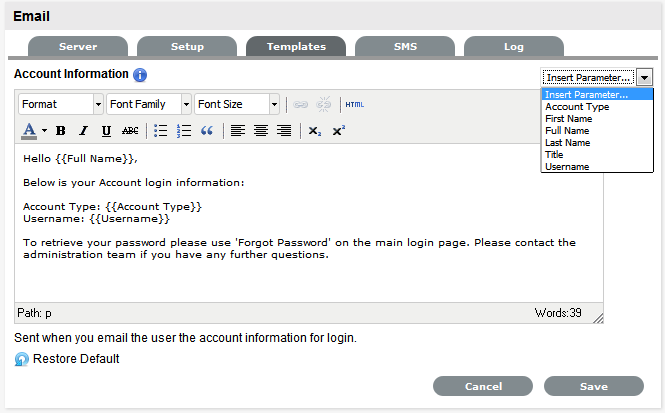
-
Click Save.
NOTE:Approval Change, Approval Service Request, Create Problem and Create Change, Create Service Request apply to Service Manager Only.
Approval Messages
As the system allows Managers to approve or reject RFCs and Service Requests via email, the automatically generated emails must include specific instructions for the Manager to include either the words "accept" or "yes" to approve the RFC, or "reject" or "no" to reject the RFC in their reply. This is essential as the system will only recognize these key words when it automatically processes the email reply sent by the Manager.
NOTE:This is only applicable to Service Manager.
To use the Manager Approval Process via email, the system's email set-up must include the activation of the Email Polling functionality and the relevant Team details must include an incoming email address.
A.2.2 Content
The Content tab allows Users to configure automated messages, user interface and system objects content for language files used by the application.
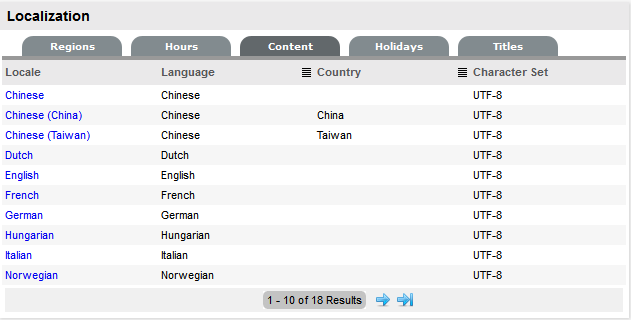
The customized content is applied to Customers and Users by setting the Email Locale option in their account information screen.
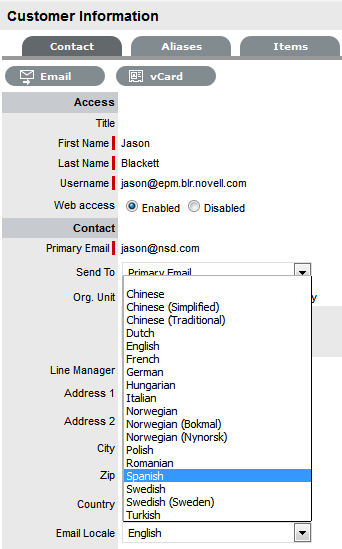
Content can be customized across the following elements and messages:
NOTE:It is recommended that the localization of user interface content, email and sms messages be done after they have been configured and reviewed within the Setup>Email and Setup>Customize tabs, respectively.
To customize content:
-
Select Setup>Localization
-
Move to the Content tab
-
Select the Locale link for the language file that is to be edited
-
Within the Category field, select the element to be customized
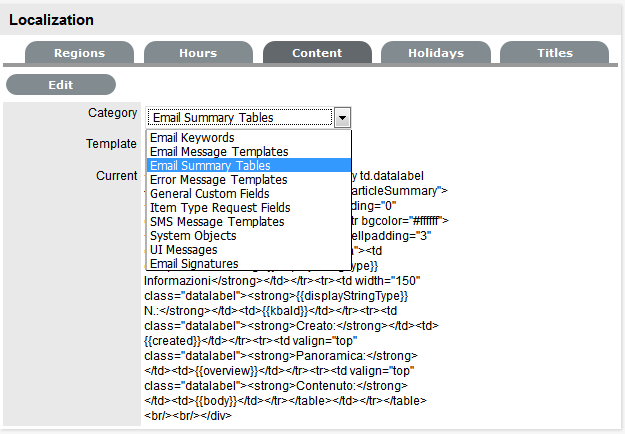
-
Within the default field displayed when the relevant Category is selected, choose the element to be customized
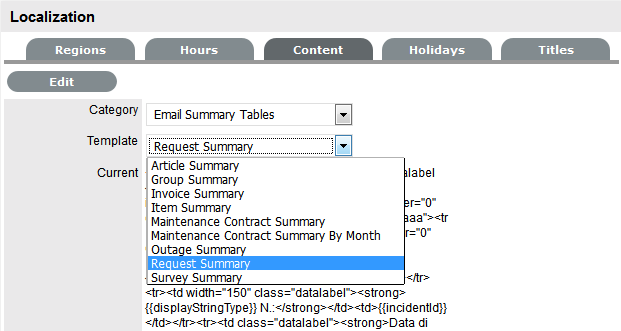
-
Click Edit
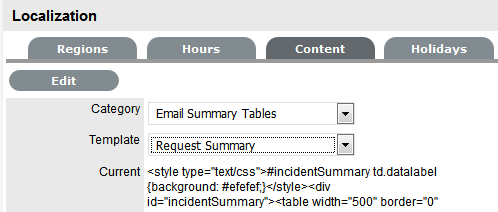
-
Amend the content and format, if required
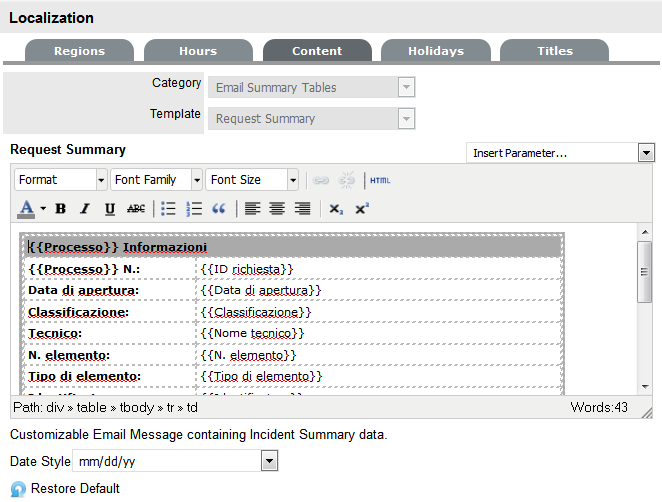
-
Click Save.
Repeat the above process for all the relevant elements in the default list or select the Content tab to return to the Locale list.
Item Type Request Fields
Item Type Request Fields
Within the system, service organizations can refine custom fields made available during the request creation process based on the Item assigned to the request. In the Fields tab a User can create custom fields that apply to the Item Type. Therefore, when a request is logged against an Item that uses an Item Type with custom fields configured within the Fields tab, the Fields are made available within the Details tab of the request creation process.
These fields are in addition to the fields created by the Administrator within the Admin>Setup>Custom Fields, which are created for the specific Process, such as Incident, Problem, Change and Service Requests.
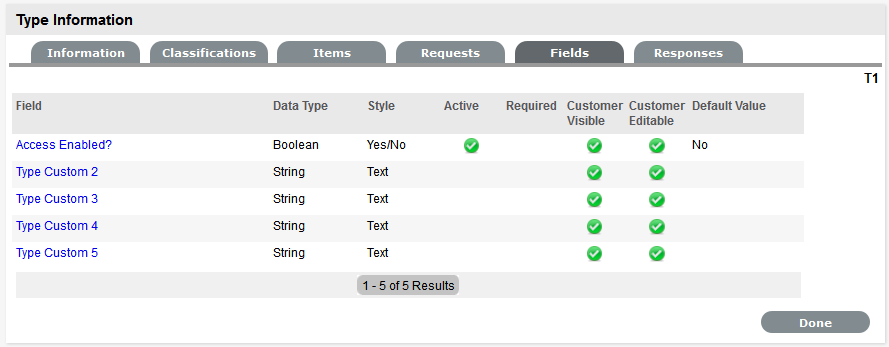
To create Field labels within the Type Information screen:
-
Click the Fields tab
-
Click Edit
-
Select a Field hyperlink
The Custom Field screen is displayed.

-
Click Yes to activate the Field
-
Complete the following details:
Categories Fields
Description
Category
Field Label
The name of the field.
Active
Indicates if the field is active.
Required
Indicates if the field is required or mandatory field.
Customer Visible
Defines if the Customer can see the field within the
Customer Portal.
If Yes is selected, define if the Customer can edit the field information on the Customer Portal.
Data Type
Dictates the field's Data Type. The options available include :
-
String - List or Free Text
-
Number
-
Boolean - radio buttons for Yes/No and True/False
-
Date - creates a date field
-
Currency- creates a currency field
-
Hyperlink.
Style
Defines how the data is recorded or presented in the field. (e.g., String - List or Free Text field.)
See Lists or below for more information about creating a list within the field.
Unique Value
When active, the system prevents the duplication of data within the customized field.
Default Value
Value entered is the default system entry for the field, when the field is not completed manually.
Input Validation
When enabled the Input Mask and User Mask can be defined.
Input Mask : A regular expression to use for data validation of values entered by a User (i.e., Zip/Post Code, telephone no.)
User Mask: A User Friendly representation of the Input Mask that Customers can understand should it appear in a validation error message.
Enable Description
When enabled a Description field appears, allowing the User to enter details of what information is the field is expected to capture. These details are accessible next to the custom field on the relevant screen.
-
-
Click Save
The active Field will now be available during the request creation process, for all Items that use the Item Type.
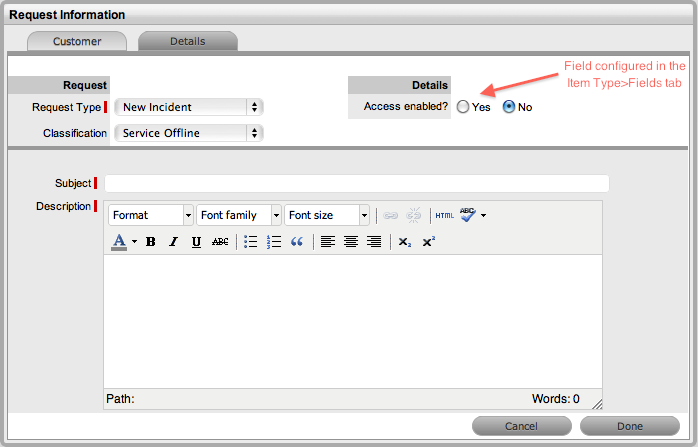
Data Type - List
When the Data Type String - List is selected the List Contents field is displayed, which provides the facility to create a drop down list to be created as options within the field.
To create a new list entry within the List Contents field:
-
Right click the Entries link
The Create option is displayed

-
Click Create
A New node link displayed

-
Enter the name of the field
-
Click outside the field to save the entry

-
Repeat this process until all list entries have been added
To create a nested list, right click on the relevant list entry and repeat the above process.
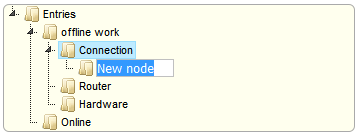
-
To move an existing entry to a new position, select the entry, then drag and drop the entry into its new location
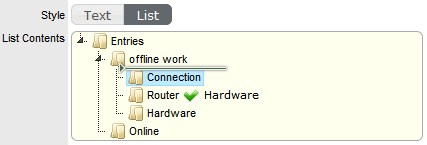
-
When all the relevant details have been defined for the custom field, click Save.
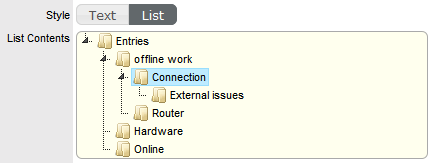
Creating Nested List Entries
List entries can be expanded to include nested options.
To create a nested list:
-
Right-click the relevant list entry header
The Create, Rename, Delete and Make Default options are displayed.
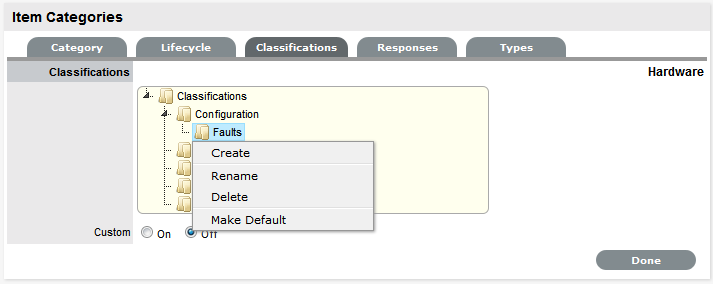
-
Select Create
A text box will appear under the list entry.
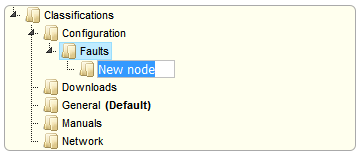
-
Enter the name for the list entry
-
Click away from the text box to commit and save the change
-
Move an existing list entry to a new position, if required
Select the entry, then drag and drop the entry into its new location
-
The above steps can be repeated until the nested list is complete.
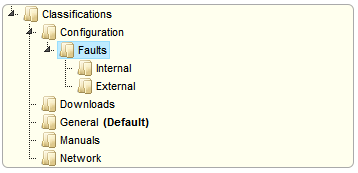
Renaming a List Entry
Any list entry can be renamed.
To rename a list entry:
-
Right-click the list entry link
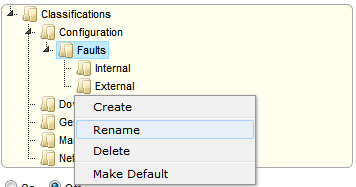
-
Click Rename
-
Edit the field content
-
Click away from the text field to save the change.
Deleting a List Entry
To delete a list entry:
-
Right-click the relevant list entry
-
Click Delete
-
Click Done when the list is complete.
Portals
All Public Access home page messages and some Customer Portal pages can be customized within the Portals tab.
Knowledge of HTML is required to edit this section. Links to documents and downloads may be added. The content can be customized for the following system Portals:
-
Name
Description
AlertHome
Accessed by clicking the Alerts link on the system Login screen.
AllServices
Visible as the header within the Service Catalog screen of the Services tab in the Customer Portal.
CustomerForums
Visible as the header within the Forums page of the Customer Portal.
ForumsHome
Visible as the header within the Forums pages of Public Forums.
Items
Visible in the Items tab within the Customer Portal.
KnowledgeHome
Accessed by clicking the Knowledge Base link on the system Login screen.
Login
Visible on the screen where system users enter their login credentials.
Logout
Visible on the page displayed when system users log out.
OutagesHome
Accessed by clicking the Outage link on the system Login screen of Service Manager installations.
PlannedHome
Accessed by clicking the Planned Outage link on the system Login screen of Service Manager installations.
Requests
Visible in the Requests tab within the Customer Portal.
SelfHelp
Visible in the Self Help tab within the Customer Portal.
Services
Visible as the header within the Services tab of the Customer Portal.
SurveyHome
Displayed in the public online surveys page.
Welcome
Displayed on the landing page when the Customer logs into the Customer Portal.
To customize a Portal message:
-
Select Setup > Customize
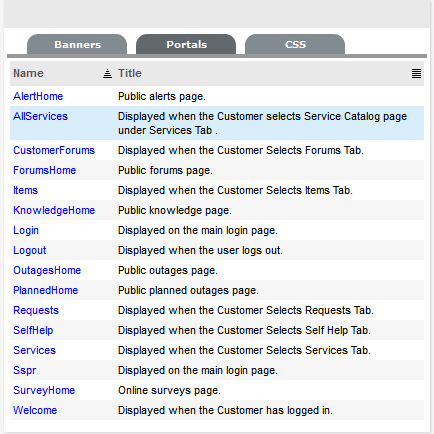
-
Select the Name hyperlink
The HTML editor appears.
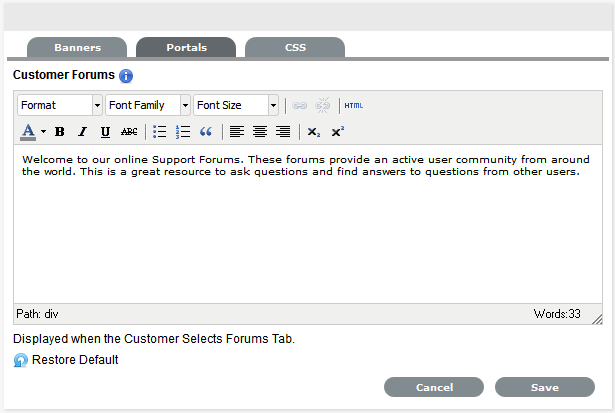
-
Edit the message as required
-
Click Save.
Cascading Style Sheets
The system can be further customized using cascading style sheets (CSSs) to amend:
-
Color
-
Fonts
-
Tabs
-
Graphics.
See: CSS Tab.
Email Parameters
The drop-down options included in the Email Parameters lists used within the Full Email Templates throughout the application, are drawn from the following parts of the system:
Parameter options for Account Information, LDAP Information, Password Information templates:
|
Parameter |
Source |
|---|---|
|
Account Type |
The Default User Role derived from the Customer or User information screen. |
|
First Name |
Derived from Customer or User information screen. |
|
Full Name |
Derived from Customer or User information screen and combines the First and Last Name. |
|
Password |
Derived from Customer or User information screen. |
|
Title |
Derived from Customer or User information screen. NOTE:This option is visible if Enable Titles is selected within the Admin>Setup>Privileges>Customer. |
|
Username |
Derived from Customer or User information screen. |
Parameters for the request, Approve Change, Approve Service Request, Closed, Closed Timeout templates:
|
Parameter |
Source |
|---|---|
|
Classification |
Drawn from the Classification field, in the Summary tab of a request. |
|
Close Date |
Shows the Close Date as recorded in the Service Terms information of the request. |
|
Country |
Derived from the Country field window in the Customer Tab of a request. |
|
Customer Name |
Derived from the Customer Field in the Summary tab of a request. |
|
Customer Phone |
Derived from the Contact Phone Field in the Summary tab of a request. |
|
Customer Room |
Derived from the Item Room Field in the Summary tab of a request. |
|
Date Style |
Detail drawn from the Admin>Setup>Privileges> Customer tab. |
|
Due Date |
Derived from the Service Terms window in the Summary Tab of a request. |
|
Email Locale |
Derived from the Contact tab of the Customer Information details. |
|
FSC Date |
Derived from the Service Terms window in the Summary Tab of a Change Request. |
|
Handshaking Close Days |
Derived from the Org Unit associated with the Customer or number of default days defined in the Setup>Privileges>Requests tab. |
|
Identifier |
Derived from the Item Identifier Field in the Summary tab of a request. |
|
Item # |
The Item Number is derived from the Item details recorded in the Customer Tab of a request. |
|
Item Type |
The Item Type is derived from the Item details recorded in the Customer Tab of a request. |
|
Last Note ID |
Shows the system generated Note identification number as a hyperlink, for the Note last added to a request. When clicked by the Customer or User, defaults to the request information screen for that request inside the system. |
|
Notes |
Details the number of Notes added to a request. |
|
Open Date |
Derived from the Service Terms window in the Summary Tab of a request. |
|
Org Unit |
Derived from the Org Unit field window in the Customer Tab of a request. |
|
Priority |
Derived from the Priority Details as recorded in the Summary tab of a request. |
|
Process |
Shows if the request is a Service Request, Incident, Problem or Change. |
|
Request Description |
Derived from the initial Description entered for the request, as recorded in the Summary tab. |
|
Request Id |
Shows the system generated request identification number. |
|
Request URL |
Shows the request identification number as a URL to allow the Customer to enter the system within the specific request screen by clicking the URL. |
|
Subject |
Derived from the Subject entered for the request that is populated from an Email Subject line or directly into the application, and recorded in the Summary tab. |
|
Team |
Shows the Team assigned to manage the request. |
|
Team Phone |
Display the Team telephone number as recorded in the Team Information screen. |
|
Technician Name |
Shows the name of the Technician assigned to the request. |
|
Title |
Derived from Customer or User information screen. NOTE:This option is visible if Enable Titles is selected within the Admin>Setup>Privileges>Customer. |
Parameter available in Contract Time templates:
|
Parameter |
Source |
|---|---|
|
Threshold |
Draws the percentage from the Threshold field in the Setup>Billing>Contracts tab. |
Options for the Invoice templates:
|
Parameter |
Source |
|---|---|
|
Adjustment |
Drawn from the Cost Calculations field, and is the amount that is deducted from the sub-total. |
|
Customer Name |
Derived from the Customer Details Name field on the invoice. |
|
Customer Title |
Derived from Customer Information screen. NOTE:This option is visible if Enable Titles is selected within the Admin>Setup>Privileges>Customer. |
|
Delivery Status |
Shows the assigned Delivery Status from the Invoice. |
|
Due Date |
Drawn from the Order Details of the invoice. |
|
Entered By |
Drawn from the Order Details of the invoice. |
|
Invoice # |
Shows the system generated Invoice Number. |
|
Invoice Date |
Drawn from the Order Details of the invoice. |
|
Invoice Status |
Derived from the Status field of the invoice. |
|
Line Items Total |
Derived from the Costs section of the Invoice and shows the overall cost for Items on the invoice. |
|
List of Item Type Line Items |
When Items are associated with an invoice, shows the details recorded in the Item Type field. |
|
List of Maintenance Contract Line Items |
When Contracts are associated with an invoice, shows the details recorded in the Contract Type Name field. |
|
Notes |
Shows any details recorded in the Notes field of the invoice. |
|
Order Date |
Drawn from the Order Details and shows the date the invoice was received. |
|
Org Unit |
Derived from the Customer Details and shows the customer's associated Org Unit. |
|
PO Number |
Drawn from the Order Details and shows the Purchase Order number associated with the invoice. |
|
Payment Date |
Shows date of payment for the invoice based on details recorded in the Invoice Status section. |
|
Payment Status |
Shows if payment has been received for the invoice based on details recorded in the Invoice Status section. |
|
Processed By |
Drawn from the Order Details and shows the name of the User who processed payment of the invoice. |
|
Shipping |
Shows the Shipping Costs as derived from the Costs section of the invoice. |
|
Shipping Date |
Derived from the Status section of the invoice and shows the expected shipping date of goods. |
|
Tax |
Drawn from the Costs Section and shows the tax applied to the invoice. |
|
Tax Rate |
Drawn from the Costs Section and shows the tax rate applied to the invoice. |
|
Terms and Conditions |
Shows details recorded in the Terms and Conditions field of the invoice. |
|
Total |
The Grand Total of the Invoice, including tax and any adjustments. |
|
Tracking Number |
Drawn from the Tracking Number field within the Status section of the Invoice. |
Parameters for the Item Status Change template:
|
Parameter |
Source |
|---|---|
|
Category |
Shows the Item Category from the Item Information tab. |
|
Criticality |
Shows the assigned Criticality of the Item as recorded in the Item Information tab. |
|
Item Number |
Shows the Item Number as recorded in the Item Information tab. |
|
Item Type |
Details the Item Type as entered in the Item Information tab. |
|
Status |
Shows the Status of the Item as recorded in the Item Information tab. |
Parameter for the New Attachment template:
|
Parameter |
Source |
|---|---|
|
File Name |
Allows the file name of the newly received attachment to be included in the email to the User. |
Parameters for the Escalation templates:
|
Parameter |
Source |
|---|---|
|
Current Technician |
Shows the name of the newly assigned Technician. |
|
Previous Technician |
Shows the name of the Technician who was previously assigned the request. |
|
Process |
Shows the ITIL Process of the request, i.e., Change, Incident, Problem or Service Request. |
|
Request ID |
Shows the Request identification number. |
Parameters for the request Status update templates:
|
Parameter |
Source |
|---|---|
|
New Status |
Shows the details of the newly assigned Workflow State. |
|
Previous Status |
Shows the Status name of the previously assigned to the request. |
|
Process |
Shows the ITIL Process of the request, i.e., Change, Incident, Problem or Service Request. |
|
Request ID |
Shows the Request identification number. |
Parameters for the SLA templates:
|
Parameter |
Source |
|---|---|
|
Hr/Min |
Shows the time as recorded in hours or minutes, based on the SLA configuration. |
|
Name |
Shows the name of the SLA. |
|
Phase |
Shows the SLA phase of Response Time, Restoration Time or Resolution Time. |
|
Process |
Shows the ITIL Process of the request, i.e., Change, Incident, Problem or Service Request. |
|
Time Elapsed |
Shows the amount of time passed for the phase of the SLA. |
|
Time Limit |
Shows the amount of total time associated with the phase of the SLA. |
Parameters for the Survey templates:
|
Parameter |
Source |
|---|---|
|
Description |
Shows the content included in the Description field of the survey. |
|
Name |
Shows the Title of the survey. |
|
Number of Questions |
Shows the number of questions included in the survey. |
Email Summary Templates
Automated email messages sent in relation to requests, Knowledge Base Articles, Items, Invoices and Contracts include a summary table of information or template. The information included in these tables, parameters, look and feel are configured within the Email Summary Templates filter screen of the Templates tab.
Knowledge of HTML would be useful when customizing the templates, but is not mandatory.
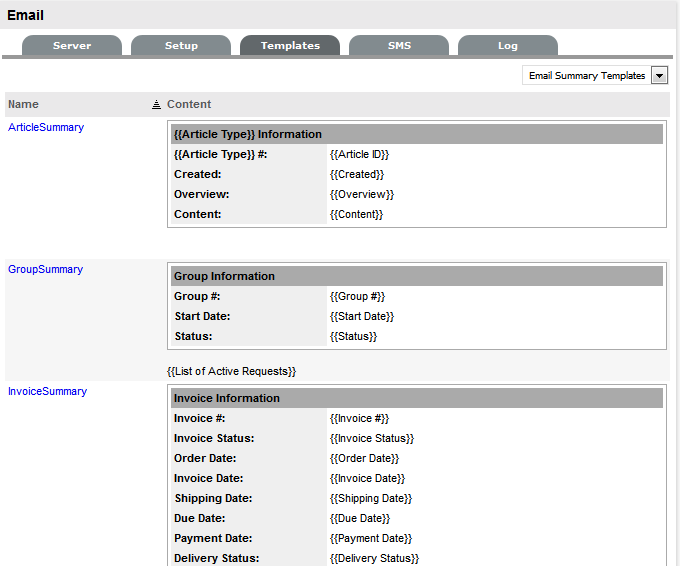
The templates for messages that can be configured within this screen include:
|
Message |
Description |
|---|---|
|
Article Summary |
Email that notifies User about the pending Review date of a Knowledge Base Article. |
|
Group Summary |
Email sent to the Users when a Request Group is created, updated or closed. |
|
Invoice Summary |
Email sent to a Customer that summarizes their Invoice information and included in all correspondence regarding the Invoice. This is forwarded with the InvoicePrefix content that is configured in the Email>Templates>Full Email Templates filter view. This template is also used for the email sent to Customers when the Setup>Billing>Contracts option is enabled and the number of days for the Subscription "Contract Renewal Time" is triggered. |
|
Item Summary |
Email sent to a Customer when a Service Item moves into an inactive State, when the email notification option is selected within the Item. |
|
MaintContract Summary |
Email sent to a Customer including their service maintenance contract details. |
|
Request Summary |
Email sent to Users when a request is created or updated. |
|
Survey Summary |
The survey summary template is included in system generated emails regarding survey notification and reminders. |
To customize the message template:
-
Select Setup > Email > Templates
-
Select the Email Summary Templates filter
-
Click the Template Name hyperlink
The HTML editor appears.
-
Modify the table, as required
As part of the customization, the Administrator can use system parameters included in the Insert Parameter drop down list. Using these options ensures the customized template includes the correct format for the information to be sent in the email.
Icon
Description
Insert Parameter
The drop-down list options ensure that the HTML correct format is used for these details to be included on the customized message.
Restore Defaults
Restores the System default email message.
-
Adjust the Date Style format, if relevant
-
Click Save.
Template Field Options
ArticleSummary
This template is included in the system generated emails for Knowledge Base Article reviews.
|
Field |
Source |
|---|---|
|
Article ID |
Knowledge Base Article number. |
|
Article Title |
Displays content drawn from the Title field. |
|
Article Type |
Shows if it is a general Article, Solution Workaround or FAQ. |
|
Content |
Drawn from the Title field of a KBA. |
|
Created |
Displays the date the Article was created. |
|
Overview |
Derived from the Problem field of a KBA. |
GroupSummary
This template is included in system generated emails when a request group is created, updated and closed.
|
Field |
Source |
|---|---|
|
Description |
Derived from the Description field on the Details tab of a requests group. |
|
Group # |
The identifying group number generated by the system for the request group. |
|
List of Active Requests |
Indicates the number of requests in an Active State contained in the request group. |
|
Name |
Drawn from the Name field on the Details tab of a request group. |
|
Start Date |
Is derived from the date that a request group is created. |
|
Status |
Derived from the Status field on the Details tab of a request group. |
InvoiceSummary
The Invoice Summary template is used when the Email button is selected within the Invoice Editor screen and when an Invoice is created and updated.
|
Field |
Source |
|---|---|
|
Adjustment |
Drawn from the Cost Calculations field, and is the amount that is deducted from the sub-total. |
|
Customer Name |
Derived from the Customer Details Name field on the invoice. |
|
Customer Title |
Derived from Customer Information screen. NOTE:This option is visible if Enable Titles is selected within the Admin>Setup>Privileges>Customer. |
|
Delivery Status |
Shows the assigned Delivery Status from the Invoice. |
|
Due Date |
Drawn from the Order Details of the invoice. |
|
Entered By |
Drawn from the Order Details of the invoice. |
|
Invoice # |
Shows the system generated Invoice Number. |
|
Invoice Date |
Drawn from the Order Details of the invoice. |
|
Invoice Status |
Derived from the Status field of the invoice. |
|
Line Items Total |
Derived from the Costs section of the Invoice and shows the overall cost for Items on the invoice. |
|
List of Item Type Line Items |
When Items are associated with an invoice, shows the details recorded in the Item Type field. |
|
List of Maintenance Contract Line Items |
When Contracts are associated with an invoice, shows the details recorded in the Contract Type Name field. |
|
Notes |
Shows any details recorded in the Notes field of the invoice. |
|
Order Date |
Drawn from the Order Details and shows the date the invoice was received. |
|
Org Unit |
Derived from the Customer Details and shows the customer's associated Org Unit. |
|
PO Number |
Drawn from the Order Details and shows the Purchase Order number associated with the invoice. |
|
Payment Date |
Shows date of payment for the invoice based on details recorded in the Invoice Status section. |
|
Payment Status |
Shows if payment has been received for the invoice based on details recorded in the Invoice Status section. |
|
Processed By |
Drawn from the Order Details and shows the name of the User who processed payment of the invoice. |
|
Shipping |
Shows the Shipping Costs as derived from the Costs section of the invoice. |
|
Shipping Date |
Derived from the Status section of the invoice and shows the expected shipping date of goods. |
|
Tax |
Drawn from the Costs Section and shows the tax applied to the invoice. |
|
Tax Rate |
Drawn from the Costs Section and shows the tax rate applied to the invoice. |
|
Terms and Conditions |
Shows details recorded in the Terms and Conditions field of the invoice. |
|
Total |
The Grand Total of the Invoice, including tax and any adjustments. |
|
Tracking Number |
Drawn from the Tracking Number field within the Status section of the Invoice. |
ItemSummary
This template is included in system generated emails for Item Status changes:
|
Field |
Source |
|---|---|
|
Category |
Shows the Item Category from the Item Information tab. |
|
Criticality |
Shows the assigned Criticality of the Item as recorded in the Item Information tab. |
|
Item Number |
Shows the Item Number as recorded in the Item Information tab. |
|
Item Type |
Details the Item Type as entered in the Item Information tab. |
|
Status |
Shows the Status of the Item as recorded in the Item Information tab. |
MaintContractSummary
This template is included in system generated emails regarding the creation and update of service contracts.
|
Field |
Source |
|---|---|
|
Contract # |
Shows the system generated Contract Number. |
|
Contract Type |
Specifies if the Contract is a Per Incident or Per Item Contract. |
|
End Date |
Includes the date the current Contract date ends. |
|
Invoice # |
Shows the system generated Invoice Number. |
|
Remaining |
Shows the amount of time remaining on a Contract. |
|
SLA |
Includes the name of the SLA included as part of the Contract. |
|
Start Date |
Shows the commencement date of the current valid Contract. |
MaintContractSummaryByMonth
This template is included in system generated emails regarding the creation and update of service contracts that are automatically renewed on a monthly or quarterly basis.
|
Field |
Source |
|---|---|
|
Contract # |
Shows the system generated Contract Number. |
|
Contract Type |
Specifies if the Contract is a Per Incident or Per Item Contract. |
|
End Date |
Includes the date the current Contract date ends. |
|
Interval End Date |
Shows the contract. |
|
Interval Remaining |
Shows the contract. |
|
Interval Start Date |
Shows the contract. |
|
Invoice # |
Shows the system generated Invoice Number. |
|
Remaining |
Shows the amount of time remaining on a Contract. |
|
SLA |
Includes the name of the SLA included as part of the Contract. |
|
Start Date |
Shows the commencement date of the current valid Contract. |
OutageSummary
This template is included in system generated emails related to Planned Outages.
|
Field |
Source |
|---|---|
|
Outage Items |
Shows the details of Items associated with the Outage. |
|
Outage Reason |
Displays the content of Reason field in the Outage information screen. |
|
Outage Related Requests |
Shows Requests related to the Outage. |
|
Outage Schedule |
Details the Start and End Date of the Outage. |
RequestSummary
The request summary template is included in emails relating to the creation, update and closure of requests.
|
Field |
Source |
|---|---|
|
Classification |
Drawn from the Classification field, in the Summary tab of a request. |
|
Close Date |
Derived from the Service Terms window in the Summary Tab of a request. |
|
Country |
Derived from the Country field window in the Customer Tab of a request. |
|
Customer Name |
Derived from the Customer Field in the Summary tab of a request. |
|
Customer Phone |
Derived from the Contact Phone Field in the Summary tab of a request. |
|
Customer Room |
Derived from the Item Room Field in the Summary tab of a request. |
|
Date Style |
Detail drawn from the Admin>Setup>Privileges> Customer tab. |
|
Due Date |
Derived from the Service Terms window in the Summary Tab of a request. |
|
Email Locale |
Derived from the Customer Information details screen and defines the language used by emails sent from the system. |
|
FSC Date |
Derived from the Service Terms window in the Summary Tab of a Change Request. |
|
Handshaking Close Days |
Drawn from the Admin>Setup>Privileges>System, unless overridden by the number of days defined in the Super>User> OrgUnit>Details tab. |
|
Identifier |
Derived from the Item Identifier Field in the Summary tab of a request. |
|
Item # |
The Item Number is derived from the Item details recorded in the Customer Tab of a request. |
|
Item Type |
The Item Type is derived from the Item details recorded in the Customer Tab of a request. |
|
Last Note Id |
Shows the system generated Note identification number as a hyperlink, for the Note last added to a request. When clicked by the Customer or User, defaults to the request information screen for that request inside the system. |
|
Notes |
Details the number of Notes added to a request. |
|
Open Date |
Derived from the Service Terms window in the Summary Tab of a request. |
|
Org Unit |
Derived from the Org Unit field window in the Customer Tab of a request. |
|
Priority |
Derived from the Priority Details as recorded in the Summary tab of a request. |
|
Process |
Shows if the request is a Service Request, Incident, Problem or Change. |
|
Request Description |
Derived from the initial Description entered for the request, as recorded in the Summary tab. |
|
Request Id |
Shows the system generated request identification number. |
|
Request URL |
Shows the system generated request identification number as a hyperlink. When clicked by the Customer or User, defaults to the request information screen for that request inside the system. |
|
Subject |
Derived from the Subject entered for the request that is populated from an Email Subject line or directly into the application, and recorded in the Summary tab. |
|
Team |
Shows the Team assigned to manage the request. |
|
Team Phone |
Display the Team telephone number as recorded in the Team Information screen. |
|
Technician Name |
Shows the name of the Technician assigned to the request. |
SurveySummary
The survey summary template is included in system generated emails regarding survey notification and reminders.
|
Field |
Source |
|---|---|
|
Description |
Drawn from the Survey Description Field. |
|
Name |
Displays the Name given to the Survey. |
|
Number of Questions |
Shows the number of questions included on the Survey. |
Keywords
Keywords are used by the system to identify how to handle inbound and outbound email from the system.
The following table includes a list of all Keywords that are used by the system, which can be customized, and where they in the appear in the application:
|
Keyword |
Direction |
Description |
|---|---|---|
|
Accept |
Inbound |
Accept or Yes is used to Approve Requests and must be included in the approval email. |
|
Accepted |
Outbound |
Included in Subject line for emails generated when a request has been accepted and sent to the person responsible managing the approval. |
|
AddToGroup |
Outbound |
Not Used. |
|
Article |
Outbound |
Included in the Subject line of emails sent to Customers including an Knowledge Base Articles. |
|
Author |
Outbound |
Included in content of Forum update message. |
|
AutoReply |
Outbound |
Included in the Subject line of emails for error messages. |
|
ChangeRequest |
Inbound Outbound |
Customer must include in email Subject line when updating a Change Request. Automatically included in Subject line of Change Request emails. |
|
ChatLog |
Outbound |
Used in the Subject line of emails sent to Customer with a copy of a chat transcript. |
|
Classification |
Inbound |
Included in Subject line with keyword “Item” e.g. Item Classification. Cannot be used alone. |
|
Closed |
Outbound |
Included in Subject line of email responding to request, e.g. Incident Closed. |
|
Contract |
Outbound |
Used in Subject line regarding Contract activity (i.e, Contract Active or Contract Low). |
|
Created |
Outbound |
Included in Subject line of email responding to creation of a request, e.g. Request (or Invoice) Created. |
|
Customer |
Outbound |
Keyword in Subject line of email regarding a Contract status, e.g. Customer Name Contract Active |
|
DeEscalated |
Outbound |
Included in Subject line of email to User regarding a request being de-escalated. |
|
Deleted |
Outbound |
Included in Subject line of email regarding a deleted request (or Invoice), e.g. Request Deleted. |
|
Delivered |
Outbound |
Included in Subject line of email regarding an Invoice, e.g. Item Delivered. |
|
Details |
Outbound |
Included in Subject line of email responding to a request, e.g. Request (or Invoice) Details. |
|
Escalated |
Outbound |
Included in Subject line of email responding to request, e.g. Request Escalated. |
|
Forum |
Outbound |
Keyword in Subject line e.g. Forum Update |
|
Group |
Outbound |
Not used |
|
Hours |
Inbound & Outbound |
Used in emails when the system refers to hours. For example, SLA and Contract emails. |
|
Incident |
Inbound Outbound |
Customer must include in Subject line, when updating an Incident. Automatically included in Subject line for emails generated regarding Incidents. |
|
IncidentQueue |
Outbound |
Inserted as the technician name when a request is assigned to the request Queue and the Technician Name is configured as a parameter in the outgoing email. |
|
Invoice |
Outbound |
Keyword in Subject line, e.g. Invoice Created (or Details/Deleted/Delivered). |
|
Item |
Inbound Outbound |
Keyword in Subject line, e.g. Item Classification. Keyword in Subject line e.g. Item # Contract Active, or Item # Status Update |
|
Minutes |
Inbound & Outbound |
Used in emails when the system refers to minutes. For example, SLA and Contract emails. |
|
NewNote |
Outbound |
Included in content of email advising that a new Note has been added to a request. |
|
NewSolution |
Outbound |
Not used. |
|
No |
Inbound |
Reject or No is used to Reject Requests and must be included in the rejection email. |
|
OrgUnit |
Outbound |
Keyword in Subject line of email regarding contract status, e.g. OrgUnit Name Contract Active |
|
PlannedOutage |
Outbound |
Included in Subject line of automated email notifications about planned Item outages. |
|
Prefix |
Inbound & Outbound |
Included as prefix in email subject line. |
|
Problem |
Outbound |
Automatically included in Subject line for emails generated regarding Service Requests. |
|
Reassigned |
Outbound |
Included in the Subject line of emails sent regarding reassigned requests. |
|
ReceivedMessage |
Outbound |
Included in content of email replying to Customer attempting to update a request that has already been closed. (Subject line Request closed.) |
|
Reject |
Inbound |
Reject or No is used to Reject Requests and must be included in the rejection email. |
|
Rejected |
Outbound |
Included in Subject line for emails generated when a request has been rejected and sent to the person responsible managing the approval. |
|
Reminder |
Outbound |
Reminding the Manager to process a Request that is waiting for approval. |
|
Resolution |
Outbound |
Included in Subject line for emails generated regarding SLA Resolution times. |
|
Resolved |
Outbound |
Included in Subject line for emails generated regarding SLA Resolution times. |
|
Response |
Outbound |
Included in Subject line for emails generated regarding SLA Respnse times. |
|
Restoration |
Outbound |
Included in Subject line for emails generated regarding SLA Restoration times. |
|
ReviewReminder |
Outbound |
In Subject line of email reminding User to review Article, e.g. ReviewReminder Article # |
|
Service Request |
Inbound Outbound |
Customer must include in Subject line, when updating a Service Request. Automatically included in Subject line for emails generated regarding Service Requests. |
|
SolutionCreated |
Outbound |
Included in Subject line of email to Customer when a solution has been created for an open request. |
|
SolutionFound |
Outbound |
Included in Subject line of email to Customer when a solution has been found and applied to an open request. |
|
Status |
Outbound |
Included in Subject line for emails regarding , e.g. Item # Status Update |
|
SystemWarning |
Outbound: Warning of unpaid invoice. |
|
|
Unknown |
Outbound |
Used in emails when the value of parameters selected for inclusion are not known. |
|
Unpaid |
Outbound |
Warning of unpaid invoice. |
|
Updated |
Outbound |
Included in Subject line of email, e.g. Request Updated. |
|
Yes |
Inbound |
Accept or Yes is used to Approve Requests and must be included in the approval email. |
Customize Keywords
To allow the system to recognize an alternative word for a System Keyword:
-
Select Setup>Email>Templates
-
Choose the Keywords filter view
-
Click on the relevant Name hyperlink
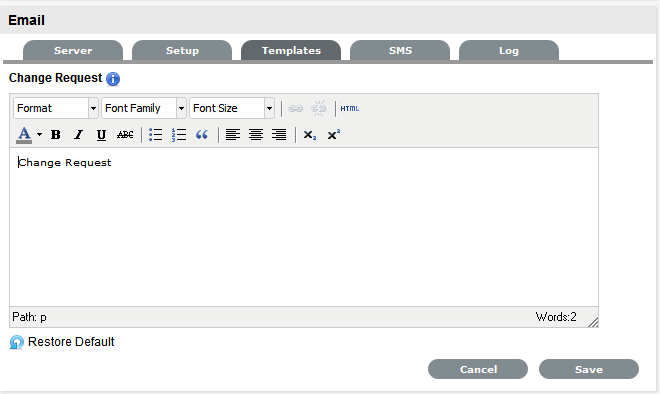
-
Enter the customized word
-
Click Save.
Error Messages
Error Messages are automatically generated and sent by the system in relation to various application activities. The following table includes details for when each Error Message is used by the system:
|
Message |
Description |
|---|---|
|
ApprovalRequiredContent |
The main content of an email sent to a Customer attempting to edit request, which is currently in “Approval” State. Such requests cannot be edited until approval is given. |
|
ApprovalRequiredSubject |
Email Subject Line content for ApprovalRequiredContent emails. |
|
InvalidTeam |
The main content of an email sent regarding the system receiving an email including an address and name of Team that does not match. For example, email may have been intended for Change Team but used Incident Team address, or vice versa. |
|
NoAccessToItemContent |
The main content of an email sent when the system receives an request via email that includes an Item# in the Subject line that the Customer does not have access. |
|
NoAccessToItemSubject |
The Subject Line of an email sent when the system receives an request via email that includes an Item# in the Subject line that the Customer does not have access. |
|
NoIncidentFoundContent |
The main content of an email sent by the system when it cannot find the Incident # referred to in the email. |
|
NoIncidentFoundSubject |
Email Subject Line content for NoIncidentFoundContent emails. |
|
NoPermissionChangeContent |
The body of the email sent when a Customer tries to log a Change Request via email and the"Create Change Requests" option is disabled in the Admin>Setup>Privileges>Customer tab. |
|
NoPermissionChangeSubject |
The Subject line content included on NoPermissionChangeContent emails. |
|
NoPermissionIncidentContent |
The body of the email sent when a Customer tries to log an Incident via email and the"Create Incidents" option is disabled in the Admin>Setup>Privileges>Customer tab. |
|
NoPermissionIncidentSubject |
The Subject line content included on NoPermissionIncidentContent emails. |
|
NoPermissionProblemContent |
The body of the email sent when a Customer sends a request a Problem Management Team. |
|
NoPermissionProblemSubject |
The Subject line content included on NoPermissionProblemContent emails. |
|
NoPermissionRequestContent |
The body of the email sent when a Customer tries to log a Service Request via email and the Create Service Requests option is disabled in the Admin>Setup>Privileges>Customer tab. |
|
NoPermissionRequestSubject |
The Subject line content included on NoPermissionRequestContent emails. |
|
NoServiceIncidentContent |
The content of the email sent when a Customer tries to log an Incident for a Service by including the Item# in the Subject line of their email addressed to the Incident Team, and the"Service Incident" option is disabled in the Admin>Setup>Privileges>Customer tab. |
|
NoTeamFound |
The main content of an email sent by the system when it receives an email sent a Team email address that is not in the system. |
|
NoUserFound |
The Subject Line included on the NoAccount emails. NOTE:The content for emails sent by the system when it receives emails from addresses that do not exist in the system, i.e., NoAccount email, can be configured in the Full Email Templates filter of the Email>Templates tab. |
|
RequestCreationErrorContent |
The system generated email sent when an error occurs during the creation of request. An example of an error would be if the database becomes unavailable during the request creation process. |
|
RequestCreationErrorSubject |
The Subject line content included on the RequestCreationErrorContent email. |
|
UnauthorizedApprove |
The email sent when a Manager sends email attempting to approve change but does not have approval permission enabled. |
|
UnrecognizedAction |
The email sent when a Manager sends an email attempting to accept or reject a Change but does not use the keywords YES or ACCEPT, NO or REJECT. |
To edit a Message:
-
Click on the required message name link
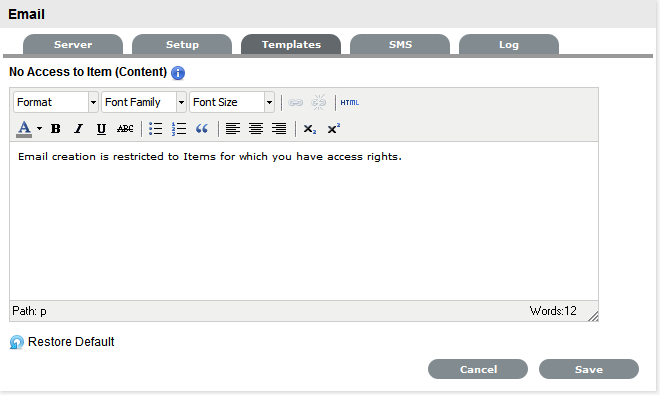
-
Update the message content
-
Click Save.
Out of Office
Users can customize multiple Out of Office options within the application, which allows the system to identify incoming email Subject lines with this message in different languages. The system will ignore emails with this content in the Subject line of emails.
To add or edit out of office messages as an Administrator:
-
Go to the Setup tab
-
Move to the Email>Templates tab
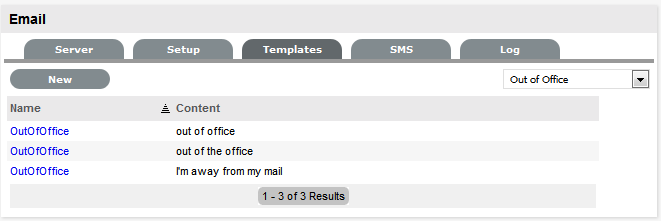
-
Select the Out of Office option
-
Click New or select the relevant message link
-
Add or amend the Subject line content that is to be identified by the system
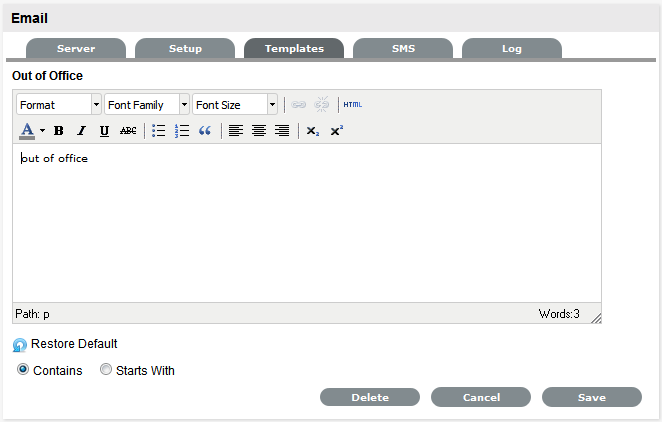
-
Click Save.
SMS Templates
The templated text and parameters for SMS messages sent from the system regarding requests and Item outages are configured within the SMS Templates filter screen of the Templates tab.
Template can be customized for the following messages sent from by the system:
|
SMS Templates |
|
|---|---|
|
ApproveChangeSMS |
Message sent to Managers when an RFC moves to an Approval State. |
|
ApproveServiceRequestSMS |
Message sent to Managers when a Service Request moves into an Approval State. |
|
ClosedRequestSMS |
Included at the beginning of the email when a request is closed. |
|
ClosedTimeoutSMS |
Used by the handshake facility and prefaces emails sent as Incident Note using the Propose button. |
|
CloseRequestLinkSMS |
Message sent with the hyperlink to enable Customers to keep a request open after a possible solution has been sent to them. If the Customer clicks on the link, the automated close process is deactivated. |
|
CloseRequestSMS |
Message sent when the handshaking facility is applied and the Technician proposes a Solution to the Customer. |
|
CreateRequestSMS |
Message sent to a Customer when a request is created. |
|
DeleteRequestSMS |
SMS sent to a User when a request is deleted. |
|
GroupCreateSMS |
SMS sent to a User when a request group has been created in the system. |
|
InvoicePrefixSMS |
Message sent to a Customer with a newly created Invoice. |
|
ItemStatusChangeSMS |
SMS sent to a Customer when an Item Status is changed. |
|
NewAttachmentToTechSMS |
SMS sent to a Technician when a Customer uploads an attachment to a request in the Customer Portal. |
|
NoteClosedPrefixSMS |
SMS sent to when a new Note is added to a closed request. |
|
NoteClosedSMS |
Sent to a Customer when they have attempted to a Note to a request that is already closed. |
|
NotePrefixSMS |
Sent each time a new Note is associated with an existing request. |
|
PlannedOutageSMS |
Included in the SMS sent when an Item is scheduled to be taken offline. |
|
RequestDeescalate FromToSMS |
Message sent when a request is manually de-escalated this message is sent to the newly assigned Technician. |
|
RequestDeescalate NotAvailableSMS |
Message sent when a request is manually de-escalated this message is sent to the previously assigned Technician to let them know that the request is no longer available for them to work on. |
|
RequestEscalateFromToSMS |
Message sent when a request is manually escalated this message is sent to the newly assigned Technician. |
|
RequestEscalateNot AvailableSMS |
Message sent when a request is manually escalated this message is sent to the previously assigned Technician to let them know that the request is no longer available for them to work on. |
|
RequestReassignedManager PrefixSMS |
This message is sent when the Manager responsible for processing the approval of a request is changed and is sent to the previously assigned Manager. |
|
RequestReassignedManager ToTechPrefixSMS |
The message included in an email when a request moves from a Manager Approval State to the newly assigned Technician User. |
|
RequestReassignPrefixSMS |
When a request is reassigned this message is sent with the request details to the previously assigned User. |
|
RequestReassignToPrefixSMS |
When a request is reassigned this message is sent with the request details to the newly assigned User. |
|
RequestStatusChanged PrefixSMS |
The content of an email sent when the Status of a request is moved from Pending-No Contract to the default open state of the assigned Workflow. This is sent to the assigned Technician. |
To customize an SMS message template:
-
Select Setup > Email > Templates
-
Move to the SMS Templates filter
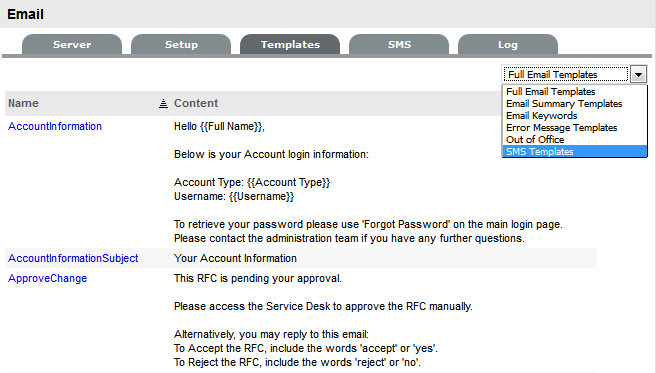
-
Select the Message Name hyperlink
The HTML editor appears.
Icon
Description
Insert Parameter
The drop-down list options provides specific details to be included on the SMS message.
Restore Defaults
Restores the system default SMS message.
-
Modify the message as required
As part of the customization, the Administrator can use the existing parameters included in the Insert Parameter drop down list. Using these options ensures the customized message use the correct format for the details regarding this information.
-
Click Save.
SMS Parameters
Parameters for new and updated Request templates:
|
Parameter |
Source |
|---|---|
|
Process |
Shows if the request is a Service Request, Incident, Problem or Change. |
|
New Status |
Shows the Workflow State assigned to the request. |
|
Request Id |
Shows the system generated request identification number. |
|
Request URL |
A direct link to the request. |
Parameters for the Group templates:
|
Parameter |
Source |
|---|---|
|
Group # |
Shows the Group ID number. |
|
Group URL |
A direct link to the request Group. |
|
Group Type |
Identifies the Group as Service Request, Incident, Problem or Change requests. |
Parameters for the Invoice template:
|
Parameter |
Source |
|---|---|
|
Invoice # |
Shows the Invoice number. |
|
Invoice URL |
A direct link to the invoice. |
Parameters for the Item Status Change templates:
|
Parameter |
Source |
|---|---|
|
Item Number |
Shows the Item Number as recorded in the Item Information tab. |
|
Status |
Shows the Status of the Item as recorded in the Item Information tab. |
Parameter for the New Attachment template:
|
Parameter |
Source |
|---|---|
|
File Name |
Allows the file name of the newly received attachment to be included in the email to the User. |
Parameters for the Planned Outage templates:
|
Parameter |
Source |
|---|---|
|
Outage End Date |
Drawn from the End Date field in the Configuration>Planned Outages screen. |
|
Outage Items |
Shows the Items associated with the Planned Outage in the Configuration>Planned Outages tab. |
|
Outage Start Date |
Drawn from the Start Date field in the Configuration>Planned Outages screen. |
Parameters for the Escalation templates:
|
Parameter |
Source |
|---|---|
|
Current Technician |
Shows the name of the newly assigned Technician. |
|
Previous Technician |
Shows the name of the Technician who was previously assigned the request. |
|
Process |
Shows the ITIL Process of the request, i.e., Change, Incident, Problem or Service Request. |
|
Request ID |
Shows the Request identification number. |
A.2.3 Email Signatures
Email Signatures that are applied at the base of all emails sent by the system are customized within the Full Email Templates filter of the Setup>Email>Templates tab. These can also be customized on a per Team basis using the Localization functionality.
To set the system default Signature:
-
Select Setup>Email
-
Go to the Templates Tab
The Full Email Templates filter view is displayed
-
Click to the final page of the Email Templates
-
Select the Signatures link
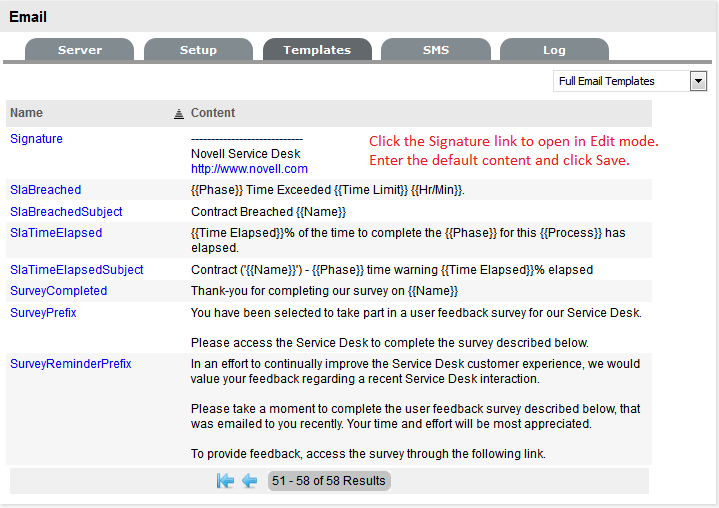
-
Edit the content
-
Click Save.
Team Signatures
After Teams have been created by the Supervisor in the User>Teams tab, an Administrator can customize the content of the Signature for the Team within the Setup>Localization>Content tab. This function allows individual signatures to be customized for each Team and in the relevant language for Customers.
To amend the Signature details on a per Team basis:
-
Select Setup>Localization
-
Click the Content tab
-
Select the Link of the language file to be customized
To create a signature file for each Team in English, select the English Locale link.
-
In the Category list select Email Signatures
A Signature list is displayed that includes the default Signature and the list of Team names configured in the system.
-
Select the Team Signature within the drop down list
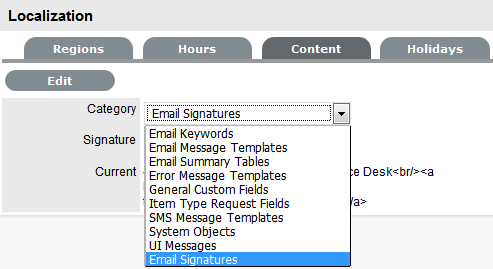
-
Click Edit
-
Amend the signature details
-
Click Save.